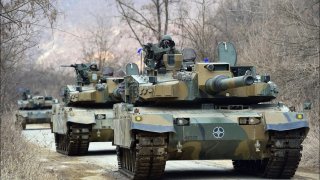South Korea’s K2 Black Panther Can Pound the North—But It Comes at a Steep Price
The South Korean Army’s K1 series of tanks is already markedly superior to its decrepit, outdated North Korean counterparts, but the procurement has value as a long-term investment with a potential export windfall.
Here's What You Need to Remember: The tank weighs fifty-five tons and is meant to be powered by the domestically-produced Doosan 1,500 horsepower engine, outputting a top speed of seventy kilometers per hour.
South Korea’s K2 Black Panther is, by most measures, the most expensive main battle tank (MBT) in the world. As one of only a handful of currently-serving fourth-generation MBTs, it is also among the most sophisticated.
In the 1990s, Seoul set out to procure a next-generation MBT. The South Korean Army’s K1 series of tanks is already markedly superior to its decrepit, outdated North Korean counterparts, but the procurement has value as a long-term investment with a potential export windfall.
The initial batch of K2 tanks rolled out in 2014, making South Korea one of the first and only owners of a fourth-generation MBT—second only to Japan’s introduction of the Type 10 MBT in 2012.
The tank weighs fifty-five tons and is meant to be powered by the domestically-produced Doosan 1,500 horsepower engine, outputting a top speed of seventy kilometers per hour.
Earlier K2 units boasted an unmanned turret scheme similar to Russia’s T-14 Armata, but the serial production model features a more traditional manned turret design. The main armament is a Hyundai 120mm smoothbore gun, with a forty-round ammunition capacity and autoloader capability. Where the K2 distinguishes itself from many of its contemporaries is in its forward-looking munitions choices. In addition to the standard MBT catalog of high-explosive rounds and kinetic energy penetrators, the K2 features Korean Smart Top-Attack Munition (KSTAM) top-attack rounds. These munitions, available in two variants-- the KSTAM-I and KSTAM-II-- are fired in a high trajectory with a range of eight km. The munition deploys a parachute mid-flight, firing an explosive penetrator downwards at a tank’s vulnerable top armor.
The K2 features a variety of design improvements suited for pitched engagements in the Korean Peninsula. These include a sophisticated fire control system, linked with shot stabilization technology to optimize accuracy in the uneven terrain. The Black Panther also boasts impressive fording capability, being able to traverse waters as deep as four meters, as well as a suspension system allowing the chassis to make dynamic profile adjustments for added maneuverability in rough or terrain.
South Korea’s venture into cutting-edge tank production has not been without growing pains. It was reported last year that South Korea outfitted its third K2 batch with a German transmission system, despite Seoul’s longstanding efforts to transition to an indigenous supply chain. In the 2010s, concerns over the reliability of a domestically-made transmission system slowed the pace of K2 deliveries to South Korea’s Armed Forces.
Transmission system woes have also cast a pall over Seoul’s ambitious export plans. South Korea has aggressively staked out a market share for the K2, starting with a 2008 technology transfer and design assistance agreement with Turkey. The deal, worth $540 million, faced an uncertain fate following engine and transmission system-related delays. Nevertheless, the K2 continues to attract foreign interest—Warsaw announced that it had entered into negotiations with Hyundai for a K2 licensed production deal, while the Norwegian Army is currently deciding whether to sign a contract for the K2 or Germany’s Leopard 2A7V.
At $8.5 million per model, the K2 is widely regarded as the most expensive currently-serving tank in the world. Still, the Black Panther arguably provides meaningful performance value for its price, and—with the notable exception of the T-14 Armata—is not terribly out of step with the costs of other fourth-generation MBTs. It remains to be seen whether or not South Korea’s big-ticket bet on next-generation tank technology pays off militarily and financially, but one thing is clear: the K2 is one of the most capable MBTs in service today.
Mark Episkopos is a national security reporter for the National Interest.
Image: YouTube

